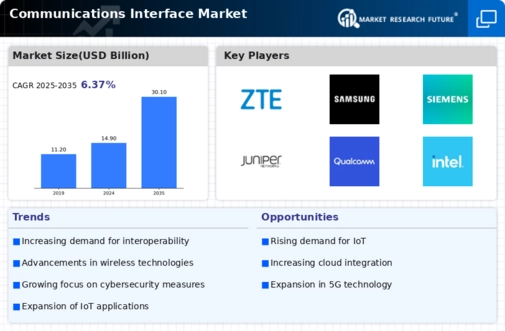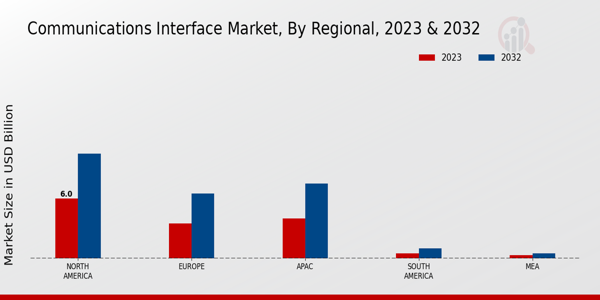Market Growth Projections
The Global Communications Interface Market Industry is poised for substantial growth, with projections indicating a market value of 14.9 USD Billion in 2024 and an anticipated increase to 30.1 USD Billion by 2035. This growth trajectory suggests a compound annual growth rate of 6.59% from 2025 to 2035, reflecting the increasing reliance on advanced communication technologies across various sectors. The demand for efficient communication interfaces is driven by factors such as the rise of smart technologies, the need for seamless connectivity, and the integration of cloud-based solutions. These dynamics indicate a robust future for the market, highlighting the critical role of communication interfaces in facilitating modern business operations.
Growing Focus on Cybersecurity Measures
The growing focus on cybersecurity measures significantly impacts the Global Communications Interface Market Industry. As communication systems become increasingly interconnected, the risk of cyber threats escalates, prompting organizations to prioritize secure communication interfaces. This heightened awareness drives investment in advanced security protocols and technologies that protect sensitive data during transmission. Industries such as finance and healthcare, which handle critical information, are particularly affected by this trend. The emphasis on cybersecurity not only enhances trust among users but also ensures compliance with regulatory standards, further propelling the demand for secure communication solutions in the market.
Rising Demand for Seamless Connectivity
The Global Communications Interface Market Industry experiences a notable surge in demand for seamless connectivity across various sectors. As organizations increasingly rely on interconnected systems, the need for robust communication interfaces becomes paramount. This trend is particularly evident in industries such as telecommunications and information technology, where the integration of diverse platforms is essential for operational efficiency. The market is projected to reach 14.9 USD Billion in 2024, reflecting a growing recognition of the importance of effective communication solutions. Enhanced connectivity not only streamlines processes but also fosters innovation, driving further investment in advanced communication technologies.
Increased Adoption of Cloud-Based Solutions
The increased adoption of cloud-based solutions plays a pivotal role in the Global Communications Interface Market Industry. Organizations are increasingly migrating to cloud platforms to enhance scalability and flexibility in their communication systems. This transition allows for real-time data sharing and collaboration, which is essential in today’s fast-paced business environment. As more enterprises embrace cloud technologies, the demand for effective communication interfaces that can seamlessly integrate with these platforms is likely to rise. This trend is expected to contribute to a compound annual growth rate of 6.59% from 2025 to 2035, indicating a robust future for cloud-integrated communication solutions.
Expansion of Smart Technologies and Automation
The expansion of smart technologies and automation is a key driver of the Global Communications Interface Market Industry. As industries adopt smart devices and automated systems, the need for effective communication interfaces that facilitate interaction among these technologies becomes increasingly apparent. This trend is particularly pronounced in sectors such as manufacturing and logistics, where automation enhances operational efficiency. The integration of smart technologies necessitates advanced communication solutions that can support real-time data exchange and decision-making processes. Consequently, this expansion is expected to contribute to the overall growth of the market, aligning with the projected increase in market value to 30.1 USD Billion by 2035.
Technological Advancements in Communication Protocols
Technological advancements in communication protocols significantly influence the Global Communications Interface Market Industry. Innovations such as 5G technology and the Internet of Things (IoT) are reshaping how devices communicate, leading to more efficient data transfer and improved user experiences. These advancements enable faster and more reliable connections, which are crucial for applications ranging from smart cities to industrial automation. As these technologies continue to evolve, the market is expected to witness substantial growth, with projections indicating a rise to 30.1 USD Billion by 2035. This evolution suggests a shift towards more sophisticated communication interfaces that can handle increasing data demands.


























Leave a Comment